Telecommunications and cable services provider Altice USA (NYSE:ATUS) reported results in line with analysts' expectations in Q1 CY2024, with revenue down 1.9% year on year to $2.25 billion. It made a GAAP loss of $0.05 per share, down from its profit of $0.06 per share in the same quarter last year.
Altice (ATUS) Q1 CY2024 Highlights:
- Revenue: $2.25 billion vs analyst estimates of $2.24 billion (small beat)
- Adjusted EBITDA: $846.6 million vs analyst estimates of $848.3 million (small miss)
- EPS: -$0.05 vs analyst estimates of $0.01 (-$0.06 miss)
- Gross Margin (GAAP): 67%, in line with the same quarter last year
- Free Cash Flow of $63.57 million, down 68.4% from the previous quarter
- Broadband Subscribers: 4.14 million (in line)
- Market Capitalization: $933.7 million
Based in Long Island City, Altice USA (NYSE:ATUS) is a telecommunications company offering cable, internet, telephone, and television services across the United States.
The company was founded to become a comprehensive telecommunications provider. Its solutions address the need for dependable internet connectivity, varied entertainment choices, and effective communication, providing a unified solution for entertainment and communication needs.
Altice USA's services encompass high-speed internet, cable television, voice telephony, and digital television offerings, catering to both residential and business clients. The company's revenue is primarily derived from subscription-based services, and its ability to deliver a full suite of services makes it appealing to customers seeking convenience and simplification.
Cable and Satellite
The massive physical footprints of fiber in the ground or satellites in space make it challenging for companies in this industry to adjust to shifting consumer habits. Over the last decade-plus, consumers have ‘cut the cord’ to their traditional cable subscriptions in favor of streaming options. While that is a headwind, this affinity to streaming means more households need high-speed internet, and companies that successfully serve customers can enjoy high retention rates and pricing power since the options for internet connectivity in any geography is usually limited.
Competitors in the telecommunications and media services sector include Comcast (NASDAQ:CMCSA), Charter Communications (NASDAQ:CHTR), and DISH Network (NASDAQ:DISH).Sales Growth
A company’s long-term performance can give signals about its business quality. Even a bad business can shine for one or two quarters, but a top-tier one may grow for years. Altice's revenue was flat over the last five years. 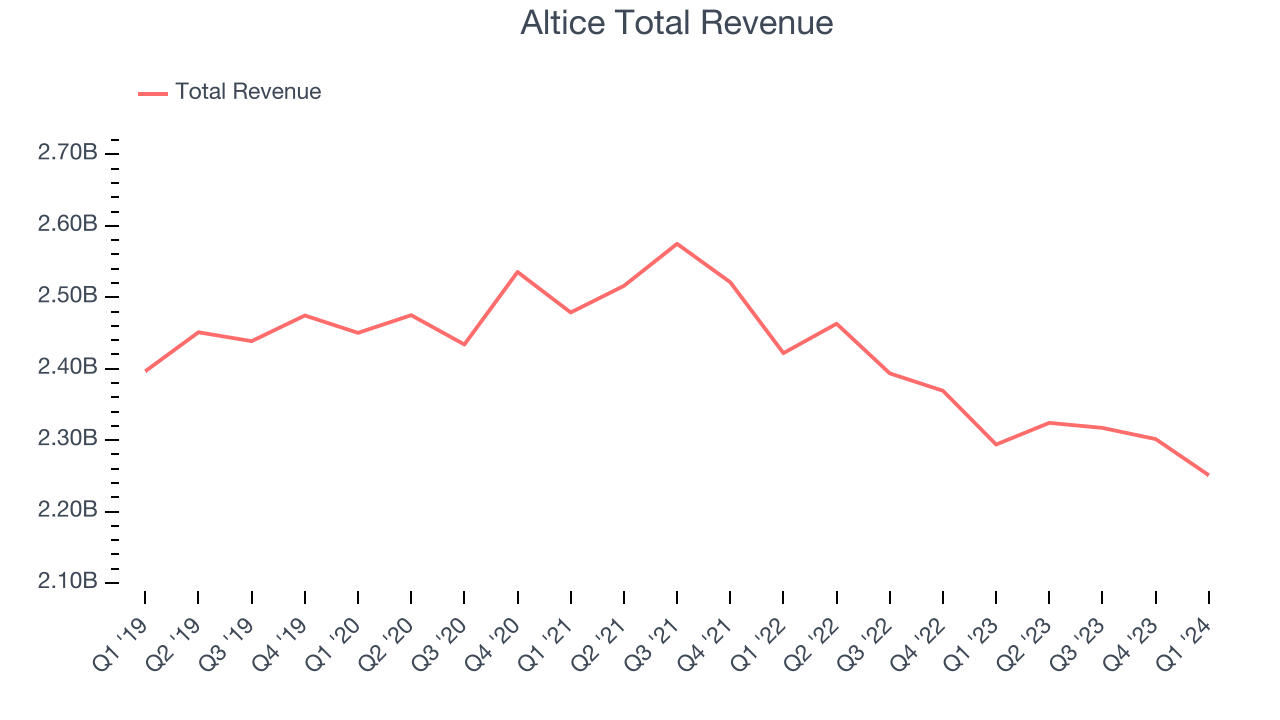 Within consumer discretionary, product cycles are short and revenue can be hit-driven due to rapidly changing trends. That's why we also follow short-term performance. Altice's recent history shows a reversal from its five-year trend as its revenue has shown annualized declines of 4.3% over the last two years.
Within consumer discretionary, product cycles are short and revenue can be hit-driven due to rapidly changing trends. That's why we also follow short-term performance. Altice's recent history shows a reversal from its five-year trend as its revenue has shown annualized declines of 4.3% over the last two years.
We can better understand the company's revenue dynamics by analyzing its number of broadband subscribers and pay tv subscribers, which clocked in at 4.14 million and 2.09 million in the latest quarter. Over the last two years, Altice's broadband subscribers averaged 2.4% year-on-year declines while its pay tv subscribers averaged 10.8% year-on-year declines. 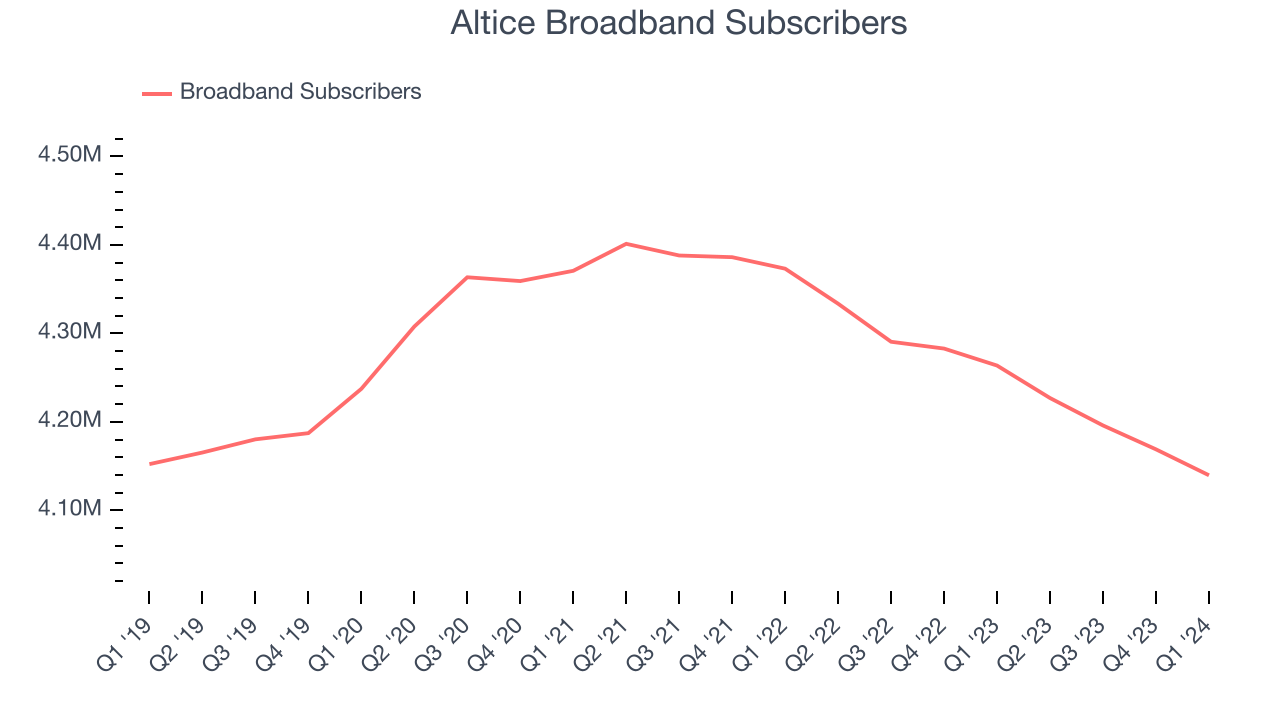
This quarter, Altice reported a rather uninspiring 1.9% year-on-year revenue decline to $2.25 billion of revenue, in line with Wall Street's estimates. Looking ahead, Wall Street expects revenue to decline 2.6% over the next 12 months, a deceleration from this quarter.
Operating Margin
Operating margin is an important measure of profitability. It’s the portion of revenue left after accounting for all core expenses–everything from the cost of goods sold to advertising and wages. Operating margin is also useful for comparing profitability across companies with different levels of debt and tax rates because it excludes interest and taxes.
Altice has been a well-managed company over the last eight quarters. It's demonstrated it can be one of the more profitable businesses in the consumer discretionary sector, boasting an average operating margin of 18.1%.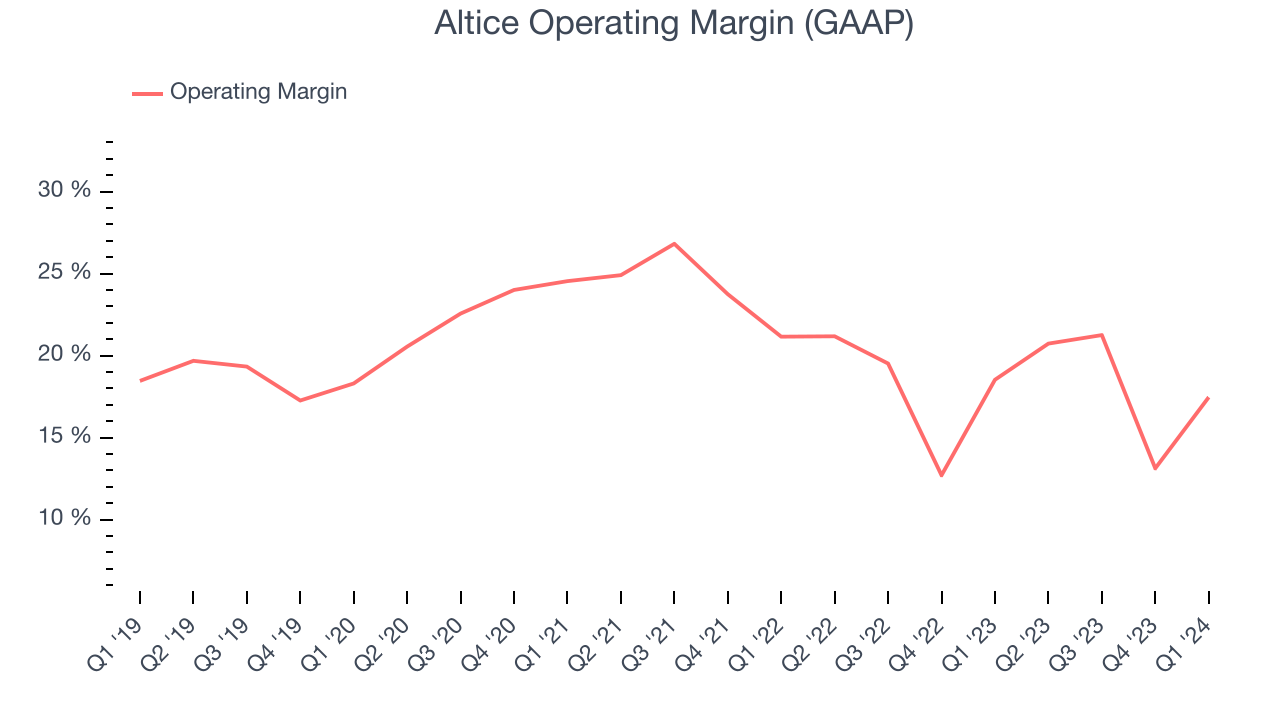
In Q1, Altice generated an operating profit margin of 17.5%, down 1.1 percentage points year on year.
Over the next 12 months, Wall Street expects Altice to become more profitable. Analysts are expecting the company’s LTM operating margin of 18.2% to rise to 19.7%.EPS
We track long-term historical earnings per share (EPS) growth for the same reason as long-term revenue growth. Compared to revenue, however, EPS highlights whether a company's growth was profitable. 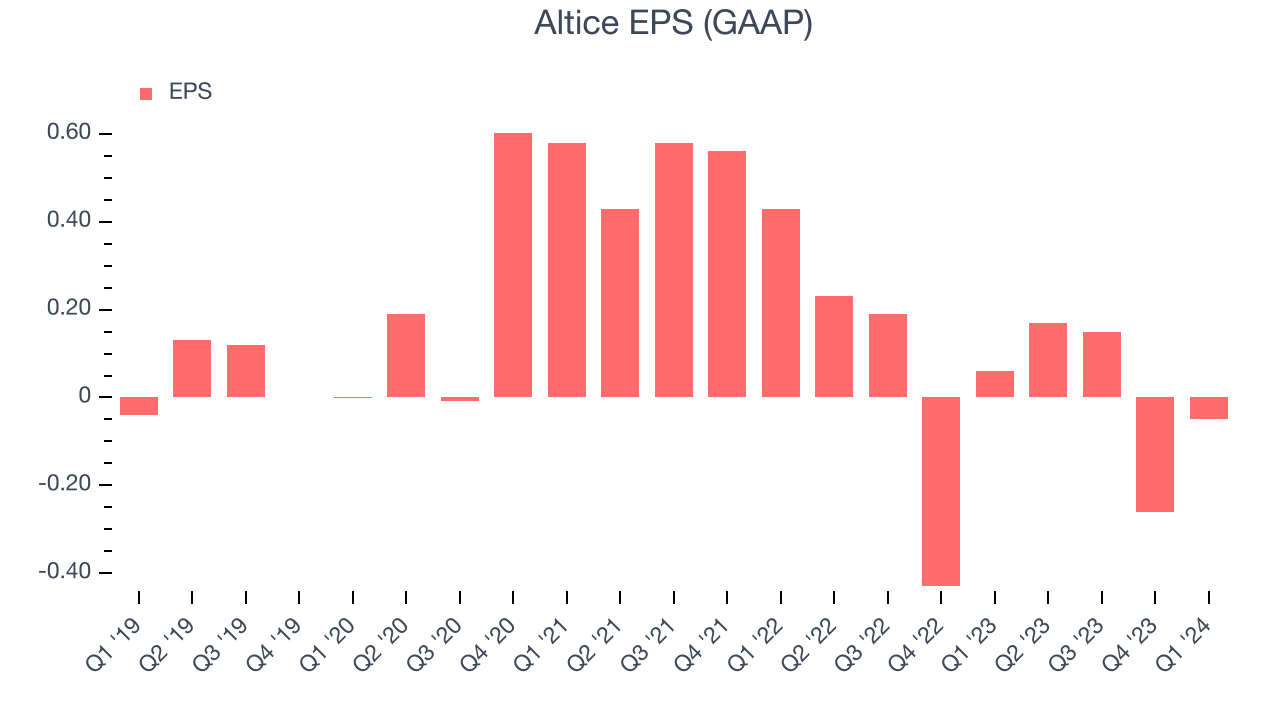
Over the last five years, Altice's EPS dropped 510%, translating into 43.5% annualized declines. We tend to steer our readers away from companies with falling EPS, where diminishing earnings could imply changing secular trends or consumer preferences. Consumer discretionary companies are particularly exposed to this, leaving a low margin of safety around the company (making the stock susceptible to large downward swings).
In Q1, Altice reported EPS at negative $0.05, down from $0.06 in the same quarter last year. This print unfortunately missed analysts' estimates. Over the next 12 months, Wall Street expects Altice to perform poorly. Analysts are projecting its LTM EPS of $0.01 to shrink to break even.
Cash Is King
Although earnings are undoubtedly valuable for assessing company performance, we believe cash is king because you can't use accounting profits to pay the bills.
Over the last two years, Altice has shown mediocre cash profitability, putting it in a pinch as it gives the company limited opportunities to reinvest, pay down debt, or return capital to shareholders. Its free cash flow margin has averaged 2.3%, subpar for a consumer discretionary business.
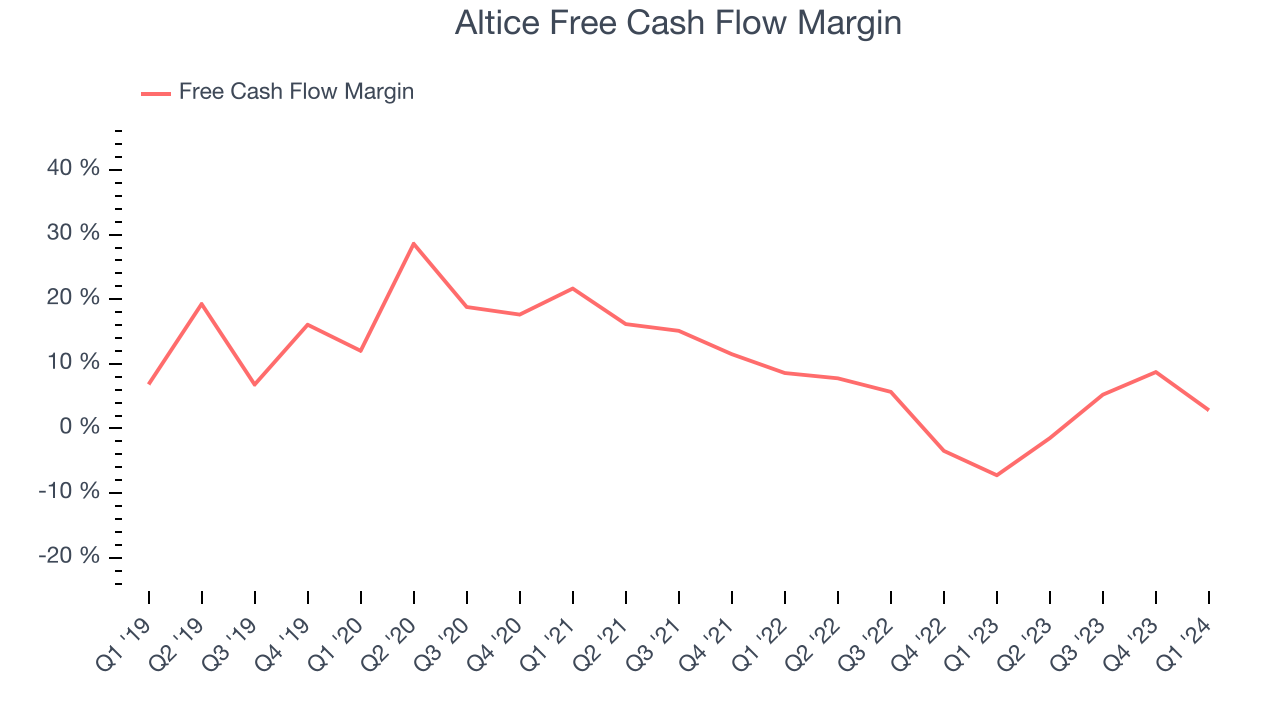
Altice's free cash flow came in at $63.57 million in Q1, equivalent to a 2.8% margin. This result was great for the business as it flipped from cash flow negative in the same quarter last year to cash flow positive this quarter.
Return on Invested Capital (ROIC)
EPS and free cash flow tell us whether a company was profitable while growing revenue. But was it capital-efficient? Enter ROIC, a metric showing how much operating profit a company generates relative to how much money the business raised (debt and equity).
Altice's five-year average return on invested capital was 7.4%, somewhat low compared to the best consumer discretionary companies that pump out 25%+. Its returns suggest it historically did a subpar job investing in profitable business initiatives.
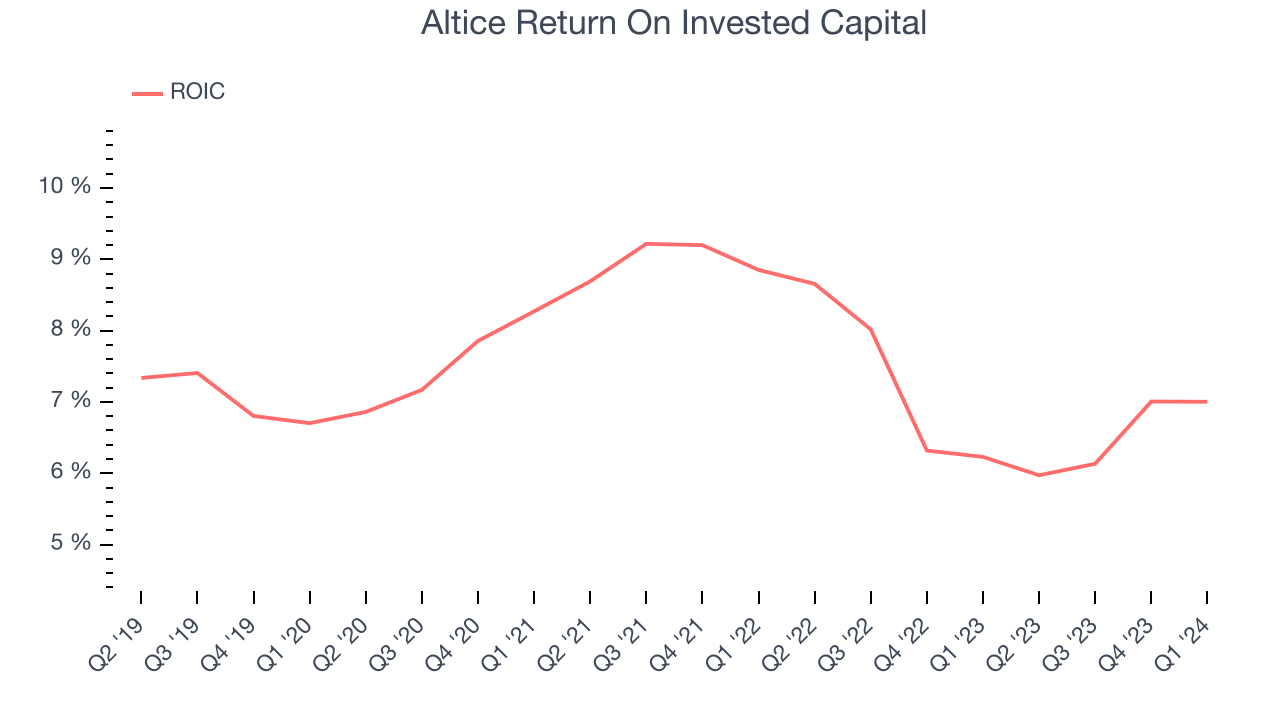
The trend in its ROIC, however, is often what surprises the market and drives the stock price. Unfortunately, Altice's ROIC has stayed the same over the last few years. If the company wants to become an investable business, it will need to increase its returns.
Balance Sheet Risk
Debt is a tool that can boost company returns but presents risks if used irresponsibly.
Altice's $24.74 billion of debt exceeds the $284 million of cash on its balance sheet. Furthermore, its 7x net-debt-to-EBITDA ratio (based on its EBITDA of $3.59 billion over the last 12 months) shows the company is overleveraged.
At this level of debt, incremental borrowing becomes increasingly expensive and credit agencies could downgrade the company’s rating if profitability falls. Altice could also be backed into a corner if the market turns unexpectedly – a situation we seek to avoid as investors in high-quality companies.
We hope Altice can improve its balance sheet and remain cautious until it increases its profitability or reduces its debt.
Key Takeaways from Altice's Q1 Results
Revenue outperformed slightly as volumes (subscribers in this case) were in line with expectations. However, the company's adjusted EBITDA and EPS both missed. Overall, the results were mixed. The stock is up 2% after reporting and currently trades at $2.08 per share.
Is Now The Time?
Altice may have had a tough quarter, but investors should also consider its valuation and business qualities when assessing the investment opportunity.
We cheer for all companies serving consumers, but in the case of Altice, we'll be cheering from the sidelines. Its revenue has declined over the last five years, and analysts expect growth to deteriorate from here. And while its projected EPS for the next year implies the company's fundamentals will improve, the downside is its number of broadband subscribers has been disappointing. On top of that, its declining EPS over the last five years makes it hard to trust.
While there are some things to like about Altice and its valuation is reasonable, we think there are better opportunities elsewhere in the market right now.
Wall Street analysts covering the company had a one-year price target of $3.54 per share right before these results (compared to the current share price of $2.08).
To get the best start with StockStory, check out our most recent stock picks, and then sign up for our earnings alerts by adding companies to your watchlist here. We typically have the quarterly earnings results analyzed within seconds of the data being released, and especially for companies reporting pre-market, this often gives investors the chance to react to the results before the market has fully absorbed the information.
